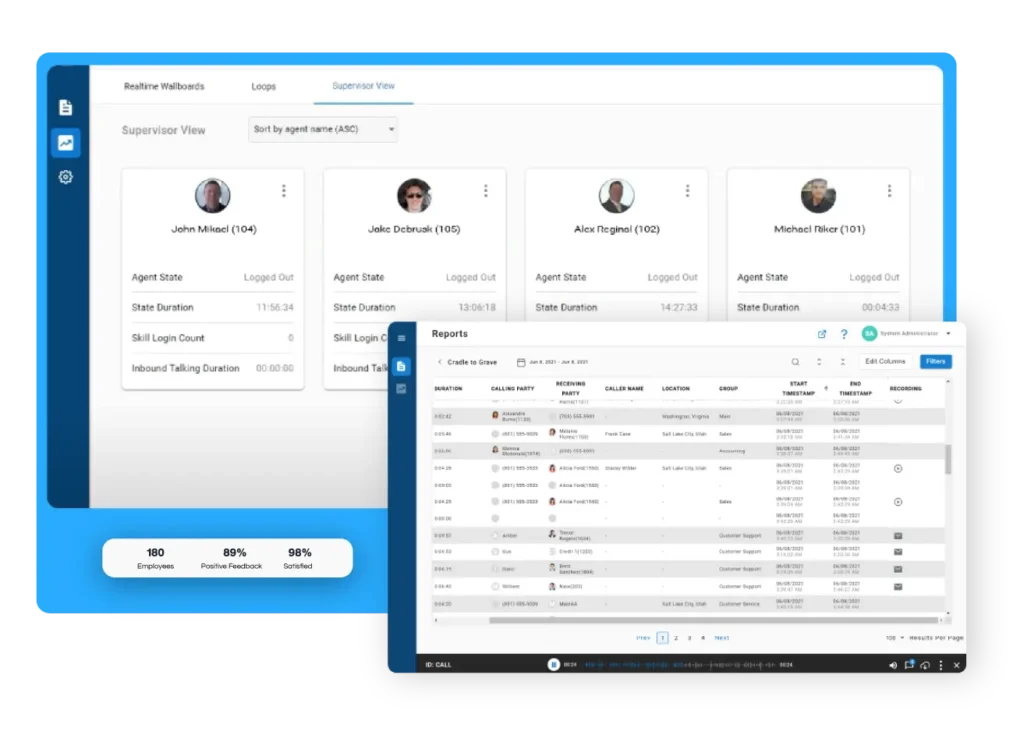Businesses that embrace AI-powered IVR aren’t just improving customer satisfaction—they’re transforming efficiency across departments. From reducing call center workloads to providing real-time insights that refine customer experience, AI is helping organizations turn every phone call into a smarter, smoother interaction. Let’s examine how AI IVR is reshaping communication and what benefits businesses can expect when they make the switch.
Key Takeaways
- AI IVR (Artificial Intelligence Interactive Voice Response) is an intelligent voice response system that uses artificial intelligence to understand natural language, interpret caller intent, and deliver personalized, conversational customer interactions.
- AI IVR understands natural speech and adapts in real time to deliver personalized responses, while traditional IVR relies on static, menu-driven options that require callers to follow preset prompts.
- The five main benefits of AI IVR are enhanced customer experience, improved efficiency and reduced costs, intelligent call routing, seamless omnichannel engagement, and actionable data.
What is AI IVR?
AI IVR, or Artificial Intelligence Interactive Voice Response, is a modern communication system that uses artificial intelligence to interact with callers in a more natural and intuitive way. Unlike traditional IVR systems that rely on rigid menu options, AI IVR understands spoken language, interprets intent, and responds conversationally. This creates a faster, more personalized experience for customers.
These systems are powered by technologies like Natural Language Understanding (NLU), machine learning (ML), and conversational AI. NLU allows the system to comprehend speech and identify what the caller means rather than just what they say. ML helps the system get smarter over time as it processes more interactions. Conversational AI ties it all together by enabling human-like dialogue and guiding customers through self-service options or routing them to the right department without frustration. Overall, AI IVR helps businesses streamline communication, improve response times, and deliver better customer experiences with every call.
The 5 Major Benefits of AI in IVR
1. Enhanced Customer Experience (CX)
AI IVR transforms traditional call interactions into smooth, conversational experiences that feel more natural and human-like. Instead of forcing customers to navigate rigid menus, it listens, interprets, and responds intelligently based on their needs. AI IVR leverages caller data and history to personalize every interaction, such as greeting returning customers by name or recognizing the purpose of their call before they explain it.
This level of personalization builds trust and satisfaction. In fact, 63% of customers expect companies to know their unique needs. With AI IVR, businesses can deliver faster resolutions and friendlier service, turning every call into an opportunity to strengthen customer relationships.
2. Improved Operational Efficiency & Lower Costs
For businesses, AI IVR means less time spent on repetitive tasks and more time focused on meaningful interactions. Automating routine inquiries like appointment scheduling, balance checks, or order status updates helps reduce call volumes and free up human agents for more complex issues.
This improves productivity and cuts call center costs, one of the biggest operational pain points for many organizations. According to IBM, businesses implementing AI-powered automation in customer service can reduce costs by up to 25%.
3. Intelligent Call Routing
AI IVR takes routing to a new level by using sentiment analysis and intent recognition to send callers directly to the most appropriate agent or department. This intelligent, skills-based routing reduces misdirected calls, shortens wait times, and ensures that customers speak with the right person from the start.
For example, if a caller sounds frustrated or mentions billing, the system can detect tone and keywords to prioritize routing to the right support specialist. This helps boost first-call resolution rates and keeps customer satisfaction high.
4. Seamless Omnichannel Experience and Sustained Engagement
A modern AI IVR does not stop at phone calls; it integrates into a unified, multi-channel communication system that connects voice with text, chat, and other digital channels. This means a conversation can start on a call and smoothly continue via text or a messaging app without losing context or repeating information.
Connecting communication channels helps businesses maintain continuous engagement and meet customers wherever they are. This creates a cohesive experience that strengthens brand perception and encourages long-term loyalty.
5. Actionable Data and Insights
Every AI IVR interaction generates valuable data. Systems can automatically record and analyze call transcripts, track sentiment, and identify recurring topics or customer concerns. This information gives businesses a clear view of customer behavior and service performance.
With these insights, teams can refine their scripts, adjust routing strategies, and spot process bottlenecks before they affect customer satisfaction. According to McKinsey & Company, companies that use AI to gather customer insights see a 15-20% increase in customer satisfaction. AI IVR provides the data-driven foundation needed to continually optimize customer experience and operational efficiency.
AI IVR vs. Traditional IVR: A Head-to-Head Comparison
For many businesses, traditional IVR systems have long been the standard for managing customer calls. However, as customer expectations evolve, these older systems often fall short. AI IVR offers a more advanced, adaptive approach that enhances both user experience and business performance.
|
Aspect |
AI IVR |
Traditional IVR |
|
Interaction Style |
Conversational and human-like. Understands natural language and intent for smoother interactions. |
Menu-driven and rigid. Requires callers to navigate through numeric or preset options. |
|
Flexibility |
Adaptive and context-aware. Learns from each interaction to improve future responses. |
Static and rule-based. Limited to scripted menus that require manual updates. |
|
Data Usage |
Proactive and personalized. Uses caller history and CRM data to tailor responses and anticipate needs. |
Minimal or no data integration. Treats every call as a new interaction. |
|
Complexity Handling |
Dynamic and scalable. Can manage complex requests, route intelligently, and learn from outcomes. |
Scripted and linear. Struggles with multi-step or non-standard inquiries. |
Applications of AI IVR for Businesses
AI IVR systems can transform how contact centers and businesses manage customer interactions through:
- Automated Self-Service and FAQs: AI IVR can instantly answer common questions such as “What are your business hours?” or “What’s the status of my order?” through conversational responses. Handling these routine inquiries reduces call volume for human agents and ensures customers receive quick, accurate information anytime.
- Intelligent Call Routing and Deflection: Using NLU, AI IVR analyzes a caller’s intent and sentiment to route them to the right agent or department. It can also deflect calls to other digital channels by sending a text message with a link to a self-service portal. This keeps call queues short and helps customers resolve issues faster.
- Customer Authentication and Security: AI IVR can use voice biometrics to verify a caller’s identity within seconds. This eliminates the need for PINs or lengthy security questions, streamlining the authentication process while enhancing data protection. The result is a faster, more secure experience for both customers and agents.
- Proactive Outbound Communications: AI IVR is not limited to inbound calls. Businesses can use it to send proactive messages such as appointment reminders, order updates, or fraud alerts. These automated communications keep customers informed and reduce the number of incoming calls, helping contact centers operate more efficiently.
Leverage the Power of AI IVR with Xima
Customer expectations are rising, and traditional IVR systems can no longer keep up. AI IVR gives organizations the tools to stay competitive, improve service quality, and uncover valuable insights that drive smarter decisions. Book a demo with Xima today to see how AI IVR can enhance your customer experience and empower your team to perform at its best.
FAQs About AI IVR
Yes, AI IVR can be scaled to fit businesses of any size, including small businesses. It helps smaller teams handle higher call volumes by automating routine inquiries, routing calls intelligently, and improving response times. This allows small businesses to offer a professional, efficient customer experience without having a large call center.
Traditional IVR systems use preset menus and scripted prompts to guide callers through limited options. An AI agent, on the other hand, uses artificial intelligence to understand natural speech, interpret intent, and respond conversationally. AI IVR combines the capabilities of both.
Conversational AI IVR is an advanced voice response system that uses technologies like Natural Language Understanding (NLU) and machine learning to hold natural, two-way conversations with callers. Instead of requiring callers to press numbers or follow strict prompts, it allows them to speak freely and get instant, accurate responses that feel more like talking to a real person.
Yes, most AI IVR systems are trained on large datasets that include a variety of accents, dialects, and languages. This enables them to accurately recognize and interpret speech from a diverse customer base. Businesses can also customize their AI IVR to support specific languages or regional variations to better serve their audience.



